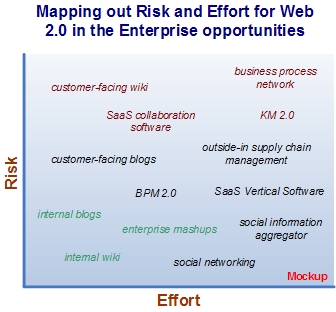Developing strategies for Web 2.0 in the Enterprise

With the all the talk recently about Web 2.0 and the enterprise, particularly around SOA, I find that it's always good to point to specific examples to bring all the pontificating down to earth. Along this line of thought, while I was catching up with the tail ends of the conversation today, I came across these excellent points by Barry Briggs:
Certainly there's much each can learn from the other. SOA is heavyweight but robust enterprise architecture; Web 2.0 is democratic, social and participant-based. On the surface, they are orthogonal. They target different problems: so it's just as hard to imagine building a lightweight wiki with SOA as it is a global supply chain with (say) MySpace.
Still, it's equally easy to imagine that supply chain services will migrate to the cloud, will be accessible by large numbers of individuals, will have rankings for and discussion boards about reliability, and simple tools with which to compose them into larger applications. Imagine Strikeiron merging with Socialtext and you get the idea.
These contrived examples do demonstrate some of the space between these two models of software, though it's certainly not the whole story. And while I don't think the gap is as large or quite as dysfunctional as John Hagel or Barry do, I do think traditional views of enterprise IT make it hard to look outside the box and visualize what's possible. For one thing, risk is something that most corporations manage closely and unless the company is a well-known risk taker, it doesn't make a lot of sense to jump into seemingly unproven Web 2.0 techniques no matter the potential benefits. Then there are the unknowns about unleashing democratizing forces or even determining the outcome, level of effort, and actual cost of using these tools.
Of course, this is true of almost any IT project, and folks like Rod Boothby have done a good job recently explaining why things really haven't changed much in the enterprise space for a while now. For one thing, there's too little time left in most professionals' busy schedules to use many additional productivity tools unless they truly result in a net savings of time:
Corporate America, Enterprise Europe and Big Business Japan are awash with six figure MBAs who spend 50% of their time cutting and pasting between Word and Excel files. They spend another 40% of their time answering an endless chain of CC to CYA emails. That leaves 10% left for these brilliant capable people to add value.
The problem with my previously posted Enterprise Web 2.0 software list is that it's missing discrete scenarios for enterprise uses of these applications. The shift of control from organization to individual seems to be part of the problem. The advent of widespread Social Computing in the form of user generated content and democratization of control over media changes the basic perspective, and probably makes it harder to see many of the scenarios.
So what I'd like to do is put together a list of Enterprise Web 2.0 solution scenarios to help frame up the possibilities for each of the major categories. Each scenario will cover a product category and show how the Web 2.0 solution could be applied to specific business situations inside the enterprise and out across the Web both. Along those lines, I'd also like to put together a rough matrix of the risk and effort level for implementing these with respect to each other. List like the ones Jeff Nolan and others put together but that provide the enterprise context that is needed so the specific advantages (and risks) are clear.
Armed with more actionable information like this and early implementers will have some good basic ideas on where to starting using these potentially disruptive yet largely beneficial technologies. (Disruptive to their competitors who don't use them, or to themselves if they don't, that is.)

Over the next couple of weeks, look for me to explore this approach to see if we can learn more about how to move the widespread innovation occurring on the Web into the enterprise.
Update: Here are the Web 2.0 in the enterprise stratagies explored so far:
Blogs, Wikis, BPM - Part 1, BPM - Part 2, Web 2.0 Architecture: WOA and REST
Will adding an enterprise context to Web 2.0 software make them suitable for the enterprise, or perhaps negate their advantages?